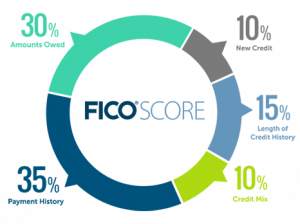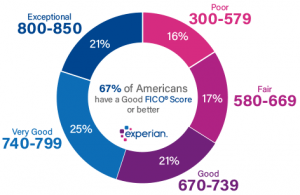FICO Score

FICO Score is a credit scoring model developed by the data analytics company, FICO (Fair Isaac Corporation). Similar to other credit scoring systems, FICO Score's algorithm uses debt data from an individuals credit report to formulate the score.[2] The score is used as a metric for lenders to determine whether or not to an individual is a credit risk or not.[3]FICO is currently the most widely used credit scoring algorithm in The United States of America. Particularly, FICO 8, the eighth version of the FICO score is used by the three main credit bureaus in the United States. Commonly referred to as the "big three" they are Experian, TransUnion, and Equifax.[4]
Contents
FICO
About
FICO is a data analytics company that serves its corporate client base by assisting their business decisions. In addition to their most well known product FICO Score, the company also has other software tools that are used to improve customer relations and optimize business interactions. Following suit with other Big Data corporations, FICO utilizes technologies such as cloud computing and open source standards.[5]
FICO operates globally in over 20 countries spanning six continents. The corporation provides solutions in an array fields such as finance, health care, automotive, telecommunications and more.[6] [7]

History
Founded in 1956 by engineer Bill Fair and mathematician Earl Isaac with hopes to improve the manner in which businesses make discussions. Two years later, the company released their first credit scoring algorithm. FICO moved their headquarters from San Fransisco, California to San Rafael California i 1961. In 1972 FICO debuted the first automated application processing system at Wells Fargo. FICO revealed another credit scoring model the FICO Credit Bureau Risk Score in 1981. The next year, FICO opens its first international office in Monaco. In 1987 FICO becomes a publicly traded stock in the New York Stock Exchange. FICO moved its headquarters again to Minneapolis, Minnesota in 2004. In 2013, FICO returned its headquarters to California by moving to San Jose. [9]
Algorithm
History
Credit scoring systems had existed before the FICO Score since the 1800's for use in the commercial space. They were originally developed by lenders to systemize determining whether or not a loan would be a risk or not. These early credit systems included racial, gender and class information to aid the lending process. In the 1900's the need for credit scores grew to meet the needs of consumers as the middle class grew. To meet this demand, algorithms collected data on individuals' social, political, and sexual lives. In the 1970's, the government passed the Fair Credit Reporting Act (FCRA) which disallowed the gathering of demographical data for use in determining credit eligibility. [10] [11]
FICO Score was created in 1989 to fill the need of a standard credit scoring algorithm that was also unbiased. [12] In 1991, FICO Score is used by all three major credit bureaus in The United States. Two years later, FICO designs specialized scores for each type of loan. The most widely used version of the FICO Score, FICO 8, was released in 2009. [13]
Breakdown
The FICO Score is comprised of five major parts.

Payment history is the largest component and takes up 35 percent of the FICO Score. Particularly, this component focuses on if the individual has made payments and the timeliness of those payments. This information includes the history of credit card, home loan, and car loans. If the individual makes their payments on time their score will be higher.
Amounts owed makes up 30 percent of the FICO Score and is based on how much money the individual has actually borrowed in relation to their available credit. Typically, the less available credit an individual borrows the higher their score will be.
The length of credit history makes up 15 percent of the score. The length is determined by taking the individuals average age of credit accounts. The older the average age of accounts the higher the FICO Score will be.
The next 10 percent of the score is based on credit diversity. Credit diversity considers on the mix of credit accounts of an individual. Generally, the more variety in types credit the individual has the higher this portion of the score is.
New credit takes up the final 10 percent of the FICO Score. This portion of the score includes not only new accounts opened by the individual but also accounts that the individual has attempted to open. The less new credit lines an individual decides to open it is seen as less of a risk so their score would be higher. [15] [16] [17]
FICO Scores do not include demographics, salaries, or social information. [18]
All information used by the scoring algorithm is pulled from the individuals credit report. [19]
Scoring Range

FICO Scores range from 300 to 850 with a higher number representing a better score. The average FICO Score is around 670. FICO defines ranges for scores as <580 is poor, 580-669 is fair, 670-739 is good, 740-799 is very good, and a score 800 or higher is exceptional. Each range represents roughly 20% of all FICO Score users. [21] [22]
Competitor algorithms
While FICO score has a 90% market share there are other credit scoring algorithms that exist and are in use. The most notable competing algorithm is VantageScore. [23]
Vantage Score
VantageScore was created in 2006 by the three major credit bureaus to improve upon the existing credit scoring models. Another reason VantageScore was developed was to introduce a competitor to FICO Score. VantageScore shares many similarities to FICO Score. Both use the same information to determine its score. VantageScores also range from 300-850. [24] [25] [26]
The newest version of the VantageScore, VantageScore 4.0, uses machine learning algorithms in determining its scores. It is the only credit scoring algorithm to do so. [27]
Discrimination concerns
Racial bias
One of the major criticisms of credit scores in general are that they are built with an inherent racial bias. Proponents of this claim believe that the algorithms that are used to determine credit scores have racial bias "baked in" to them. Minority groups are typically negatively impacted from the bias. [28] Despite these claims, designers of modern credit scoring systems say that the purpose of scores were to eliminate all kinds of bias from lending. [29]
A contention used for criticizing racial bias in credit scores is the long history of discrimination against minority groups in America. Lynette Khalfani-Cox cofounder of The Money Coach and New York Times bestselling author explains, "From the 1930s to the 1960s, the federal government flat-out refused to insure home loans for Black people. This meant that 98 percent of the loans approved went to White Americans, which created the White middle class.” [30] [31] Congress passed the Fair Housing Act and Equal Credit Opportunity Act in the sixties and seventies. However, the effects from the past policies led to the modern racial wealth, information, and access gaps. FICO Score and other credit scoring algorithms are reflections of these gaps. [32] [33] Despite these claims, designers of modern credit scoring systems say that the purpose of scores were to eliminate all kinds of bias from lending. [34]
Racial disparity in FICO Scores are deemed to be caused by ethnic gaps. Furthermore, credit scores can be used to further the racial gaps. Having a lower credit score can hinder a persons ability to obtain a loan, impact cost of insurance, and decrease the chances of securing housing. [35]
A Study by the Consumer Financial Protection Bureau, conducted in 2012, examined FICO Score variations amongst different racial subgroups. It was discovered that the median FICO Score for zip codes that were mostly inhabited by minorities had were in the 34th percentile of all FICO Scores while not minority dominated zip codes were in the 51st percentile. [36]
Representatives at FICO say that the they models use to determine ones credit score were not developed with any discrimination. From Frederic Huynh of FICO, "I am troubled when I read allegations in the press that FICO® Scores discriminate against people of color. That’s because a credit score is nothing more than the output of a mathematical formula built to rank-order the likelihood that a person will repay the debts they have incurred." [37]
In 2010, the Finance Reserve Board conducted a study to see if credit scoring produces a disparate impact. They found that credit scoring models did not have any proxies for race or ethnicity. The study also found that distributions of credit scores are mostly unaffected if the scoring models were deployed in an ethnically neutral environment. [38]
Debt discrimination
Employment
Employers that use debt checks on potential job candidates can filter qualified individuals out of the job. Many employers use credit checks as a barrier to entry for positions in an array of fields. A survey from the Society for Human Resources Management found that 47% of employers use credit checks on some or all job applicants. [39] From the same survey, it was reported that one in seven applicants said that they had been denied a job due to their credit situation. These credit checks may not take into account the reasoning behind why an individuals credit is not doing so well. This type of discrimination can potentially filter out highly qualified candidates. [40]
Employment bias through credit scores can generate a cycle of individuals who need a job in order to pay their bills and stay out of debt but cannot get a job generate any income. [41]
Medical Debt
A Demos survey revealed that more that half of respondents with a low credit score said that the cause was due to having large amounts of medical debt. That same study was able to conclude that a lack of good health coverage is a leading cause of poor credit. They found that someone without health coverage were more than twice as likely to report having a declining credit score over the past three years. [42]
A study by the Commonwealth Fund found that 40% of Americans who struggle to pay off medical debt have noticed a negative impact on their credit score. Furthermore, being in medical debt caused these individuals to have to resort taking on more debt in attempt to pay it off. The Study said that over eight million adults had to take out a loan or mortgage their homes in order to pay off their medical debt. Having to take out more debt to pay off existing debt is likely to tank their score more as it reflects negatively in most credit scoring algorithms. [43] [44]
These studies conclude that poor credit can be more of a sign of medical misfortune rather than an indicator of risk. [45]
Education Debt
Inaccuracies
A 2013 report from the Federal Trade Commission found that 21% of Americans had an error on their credit report with 13% having errors significant enough to effect their credit score. [46] Lower credit scores as a result of reporting errors can cause consumers to pay more in interest and not qualify for certain loans.
Correcting credit report errors can take a long time. A New York Times report tells the story of Maria Ortiz, a woman who found out her credit report had severe errors. Her report showed that she had two cars even though she did not drive and a mortgage despite her not having a house. It took Ortiz to send over 20 lettters to businesses and bureaus to fix the issues on her report. Ortiz said, “I did have a lot of credit cards, but I always paid them on time,” she said. “I only had $500 of credit card debt, maybe less, and they weren’t outstanding.” Her credit reputation has since been restored, and she has achieved a nearly perfect TransUnion score, 798, but the blemish on her record took several months to reverse and was not without consequences." [47] [48]
Credit invisibility
Predicting risk
Big data and artificial intelligence
Morality
Transparency
See also
References
- ↑ Fair Isaac Corporation. (2018). Frequently asked questions about FICO scores. Retrieved January 28, 2022, from https://www.ficoscore.com/ficoscore/pdf/Frequently-Asked-Questions-About-FICO-Scores.pdf
- ↑ Fair Isaac Corporation. (2021, October 27). How are FICO scores calculated? myFICO. Retrieved January 28, 2022, from https://www.myfico.com/credit-education/whats-in-your-credit-score
- ↑ FINRA. (2015, January 9). How your credit score impacts your financial future. How Your Credit Score Impacts Your Financial Future | FINRA.org. Retrieved January 28, 2022, from https://www.finra.org/investors/personal-finance/how-your-credit-score-impacts-your-financial-future#:~:text=A%20credit%20score%20is%20usually,the%20time%20of%20your%20application.
- ↑ University of Illinois Credit Union. (2022, January 14). Your credit score is the most important score you should know. U of I Community Credit Union. Retrieved January 28, 2022, from https://www.uoficreditunion.org/your-credit-score-is-the-most-important-score-you-should-know/
- ↑ Fair Isaac Corporation. (n.d.). About Us. FICO. Retrieved February 8, 2022, from https://www.fico.com/en/about-us
- ↑ Fair Isaac Corporation. (n.d.). About Us. FICO. Retrieved February 8, 2022, from https://www.fico.com/en/about-us
- ↑ Fair Isaac Corporation. (n.d.). Contact us. FICO. Retrieved February 8, 2022, from https://www.fico.com/en/contact-us
- ↑ Fair Isaac Corporation. (2015). From credit scoring to cloud analytics: A video history of Fico. FICO Decisions Blog. Retrieved February 8, 2022, from https://www.fico.com/blogs/credit-scoring-cloud-analytics-video-history-fico
- ↑ Fair Isaac Corporation. (n.d.). FICO history. FICO. Retrieved February 8, 2022, from https://www.fico.com/en/history
- ↑ Rob_Kaufman. (2018, July 25). The history of the FICO® score. myFICO. Retrieved February 8, 2022, from https://www.myfico.com/credit-education/blog/history-of-the-fico-score
- ↑ Fair Isaac Corporation. (n.d.). FICO history. FICO. Retrieved February 8, 2022, from https://www.fico.com/en/history
- ↑ Rob_Kaufman. (2018, July 25). The history of the FICO® score. myFICO. Retrieved February 8, 2022, from https://www.myfico.com/credit-education/blog/history-of-the-fico-score
- ↑ Fair Isaac Corporation. (2014). Learn about the FICO® score and its long history. Home | 25th Anniversary. Retrieved February 8, 2022, from https://www.fico.com/25years/
- ↑ Fair Isaac Corporation. (2021, October 27). How are FICO scores calculated? myFICO. Retrieved February 9, 2022, from https://www.myfico.com/credit-education/whats-in-your-credit-score#:~:text=Your%20FICO%20Score%20is%20calculated%20only%20from%20the%20information%20in,of%20credit%20you%20are%20requesting.
- ↑ Fair Isaac Corporation. (2018). Frequently asked questions about FICO scores. Retrieved January 28, 2022, from https://www.ficoscore.com/ficoscore/pdf/Frequently-Asked-Questions-About-FICO-Scores.pdf
- ↑ Fair Isaac Corporation. (2014). Learn about the FICO® score and its long history. Home | 25th Anniversary. Retrieved February 8, 2022, from https://www.fico.com/25years/
- ↑ Fair Isaac Corporation. (2021, October 27). How are FICO scores calculated? myFICO. Retrieved February 9, 2022, from https://www.myfico.com/credit-education/whats-in-your-credit-score#:~:text=Your%20FICO%20Score%20is%20calculated%20only%20from%20the%20information%20in,of%20credit%20you%20are%20requesting.
- ↑ Fair Isaac Corporation. (2018). Frequently asked questions about FICO scores. Retrieved January 28, 2022, from https://www.ficoscore.com/ficoscore/pdf/Frequently-Asked-Questions-About-FICO-Scores.pdf
- ↑ Fair Isaac Corporation. (2021, October 27). How are FICO scores calculated? myFICO. Retrieved February 9, 2022, from https://www.myfico.com/credit-education/whats-in-your-credit-score#:~:text=Your%20FICO%20Score%20is%20calculated%20only%20from%20the%20information%20in,of%20credit%20you%20are%20requesting.
- ↑ Resources.display. (2021, December 7). What is a good credit score? Experian. Retrieved February 9, 2022, from https://www.experian.com/blogs/ask-experian/credit-education/score-basics/what-is-a-good-credit-score/#:~:text=The%20base%20FICO%C2%AE%20Scores,is%20still%20670%20to%20739.
- ↑ Fair Isaac Corporation. (2021, October 21). What is a FICO score and why is it important? myFICO. Retrieved February 9, 2022, from https://www.myfico.com/credit-education/what-is-a-fico-score
- ↑ Resources.display. (2021, December 7). What is a good credit score? Experian. Retrieved February 9, 2022, from https://www.experian.com/blogs/ask-experian/credit-education/score-basics/what-is-a-good-credit-score/#:~:text=The%20base%20FICO%C2%AE%20Scores,is%20still%20670%20to%20739.
- ↑ Fair Isaac Corporation. (n.d.). FICO® scores are used by 90% of top lenders. FICO® Score – The Score that Lenders Use. Retrieved February 9, 2022, from https://www.ficoscore.com/about#:~:text=FICO%20%C2%AE%20Scores%20are%20the,lenders%20use%20FICO%20%C2%AE%20Scores.
- ↑ Resources.display. (2021, December 7). What is a good credit score? Experian. Retrieved February 9, 2022, from https://www.experian.com/blogs/ask-experian/credit-education/score-basics/what-is-a-good-credit-score/#:~:text=The%20base%20FICO%C2%AE%20Scores,is%20still%20670%20to%20739.
- ↑ Steele, J. (2021, September 17). What is a VantageScore credit score? Experian. Retrieved February 9, 2022, from https://www.experian.com/blogs/ask-experian/what-is-a-vantagescore-credit-score/
- ↑ VantageScore. (n.d.). About VantageScore. VantageScore. Retrieved February 9, 2022, from https://vantagescore.com/company/about-vantagescore
- ↑ VantageScore. (n.d.). Our models. VantageScore. Retrieved February 9, 2022, from https://vantagescore.com/lenders/our-models#vantage-score-4
- ↑ https://www.nclc.org/images/pdf/credit_discrimination/Past_Imperfect050616.pdf
- ↑ Holmes, T. E. (2021, November 23). How race affects your credit score. CreditCards.com. Retrieved February 9, 2022, from https://www.creditcards.com/credit-card-news/how-race-affects-your-credit-score/
- ↑ https://www.nclc.org/images/pdf/credit_discrimination/Past_Imperfect050616.pdf
- ↑ Holmes, T. E. (2021, November 23). How race affects your credit score. CreditCards.com. Retrieved February 9, 2022, from https://www.creditcards.com/credit-card-news/how-race-affects-your-credit-score/
- ↑ National Consumer Law Center. (2016, May). Past imperfect: How credit scores and other analytics ... NCLC. Retrieved February 9, 2022, from https://www.nclc.org/images/pdf/credit_discrimination/Past_Imperfect050616.pdf
- ↑ https://www.nclc.org/images/pdf/credit_discrimination/Past_Imperfect050616.pdf
- ↑ Holmes, T. E. (2021, November 23). How race affects your credit score. CreditCards.com. Retrieved February 9, 2022, from https://www.creditcards.com/credit-card-news/how-race-affects-your-credit-score/
- ↑ Ratcliffe, C., & Brown, S. (2017, November 20). Credit scores perpetuate racial disparities, even in America's most prosperous cities. Urban Institute. Retrieved February 9, 2022, from https://www.urban.org/urban-wire/credit-scores-perpetuate-racial-disparities-even-americas-most-prosperous-cities
- ↑ Consumer Financial Protection Bureau. (2012, September). Analysis of differences between consumer creditor ... Consumer Financial Protection Bureau. Retrieved February 9, 2022, from https://files.consumerfinance.gov/f/201209_Analysis_Differences_Consumer_Credit.pdf
- ↑ Huynh, F. (n.d.). Do credit scores have a disparate impact on racial minorities? FICO Decisions Blog. Retrieved February 9, 2022, from https://www.fico.com/blogs/do-credit-scores-have-disparate-impact-racial-minorities
- ↑ Federal Reserve Board. (2010). Finance and economics discussion series ... - federal reserve. Federal Reserve Board. Retrieved February 9, 2022, from https://www.federalreserve.gov/pubs/feds/2010/201058/201058pap.pdf
- ↑ Society for Human Resources Management. (2021, August 19). Research & Surveys. SHRM. Retrieved February 9, 2022, from https://www.shrm.org/hr-today/trends-and-forecasting/research-and-surveys/pages/default.aspx
- ↑ Traub, A. (2014, February 3). Discredited: How employment credit checks keep qualified workers out of a Job. Demos. Retrieved February 10, 2022, from https://www.demos.org/research/discredited-how-employment-credit-checks-keep-qualified-workers-out-job
- ↑ Irby, L. T. (2021, December 29). The major ways losing your job can impact your credit. The Balance. Retrieved February 10, 2022, from https://www.thebalance.com/how-job-loss-can-affect-your-credit-score-960980
- ↑ Traub, A. (2014, February 3). Discredited: How employment credit checks keep qualified workers out of a Job. Demos. Retrieved February 10, 2022, from https://www.demos.org/research/discredited-how-employment-credit-checks-keep-qualified-workers-out-job
- ↑ Doty, M. M. (2008, August). August 2008 issue brief - commonwealth fund. Commonwealth Fund. Retrieved February 11, 2022, from https://www.commonwealthfund.org/sites/default/files/documents/___media_files_publications_issue_brief_2008_aug_seeing_red__the_growing_burden_of_medical_bills_and_debt_faced_by_u_s__families_doty_seeingred_1164_ib_pdf.pdf
- ↑ Axelton, K. (2020, November 20). How does medical debt affect your credit score? Experian. Retrieved February 11, 2022, from https://www.experian.com/blogs/ask-experian/medical-debt-and-your-credit-score/
- ↑ Traub, A. (2014, February 3). Discredited: How employment credit checks keep qualified workers out of a Job. Demos. Retrieved February 10, 2022, from https://www.demos.org/research/discredited-how-employment-credit-checks-keep-qualified-workers-out-job
- ↑ Federal Trade Comission. (2013). Federal Trade Commission | protecting America's consumers. Federal Trade Comission. Retrieved February 10, 2022, from https://www.ftc.gov/sites/default/files/documents/reports/section-319-fair-and-accurate-credit-transactions-act-2003-fifth-interim-federal-trade-commission/130211factareport.pdf
- ↑ Rebecca White, “A Credit Nightmare, but Coming Out Better in the End,” The New York Times, January 11, 2012.
- ↑ Traub, A. (2014, February 3). Discredited: How employment credit checks keep qualified workers out of a Job. Demos. Retrieved February 10, 2022, from https://www.demos.org/research/discredited-how-employment-credit-checks-keep-qualified-workers-out-job